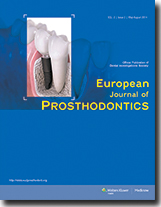 |
May-August 2014
Volume 2 | Issue 2
Page Nos. 41-69
Online since Tuesday, May 6, 2014
Accessed 47,932 times.
PDF access policy
Journal allows immediate open access to content in HTML + PDF
EPub access policy
Full text in EPub is free except for the current issue. Access to the latest issue is reserved only for the paid subscribers.
|
| |
|
|
Show all abstracts Show selected abstracts Add to my list |
|
| REVIEW ARTICLES |
|
|
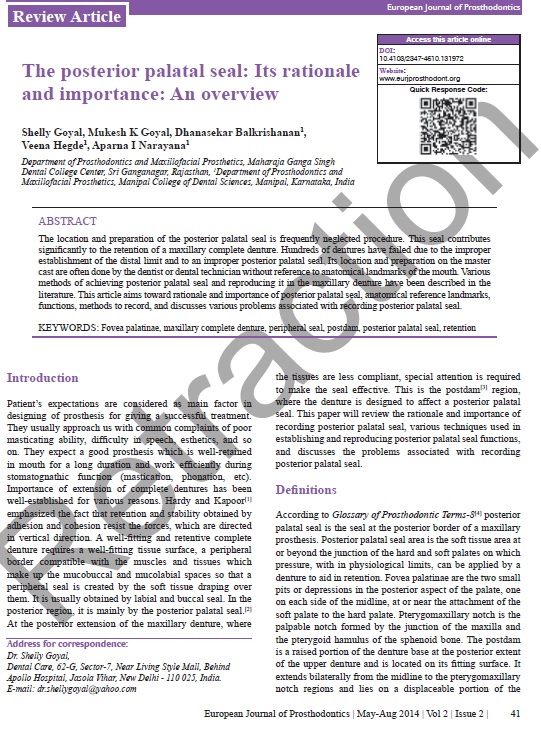  |
The posterior palatal seal: Its rationale and importance: An overview  |
p. 41 |
Shelly Goyal, Mukesh K Goyal, Dhanasekar Balkrishanan, Veena Hegde, Aparna I Narayana
DOI:10.4103/2347-4610.131972 The location and preparation of the posterior palatal seal is frequently neglected procedure. This seal contributes significantly to the retention of a maxillary complete denture. Hundreds of dentures have failed due to the improper establishment of the distal limit and to an improper posterior palatal seal. Its location and preparation on the master cast are often done by the dentist or dental technician without reference to anatomical landmarks of the mouth. Various methods of achieving posterior palatal seal and reproducing it in the maxillary denture have been described in the literature. This article aims toward rationale and importance of posterior palatal seal, anatomical reference landmarks, functions, methods to record, and discusses various problems associated with recording posterior palatal seal. |
| [ABSTRACT] [HTML Full text] [PDF] [Mobile Full text] [EPub] [Citations (2) ] [Sword Plugin for Repository]Beta |
|
|
|
|
|
|
| ORIGINAL ARTICLES |
 |
|
|
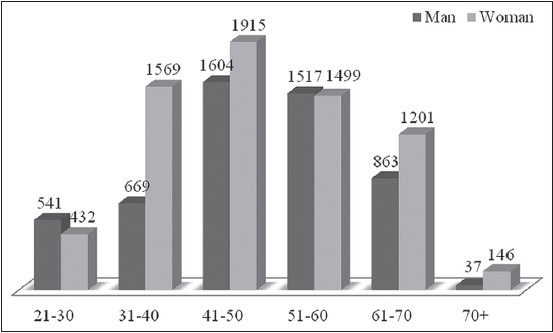  |
Prevalence of pulp exposures during tooth preparation for fixed prosthetics |
p. 48 |
Hasan Onder Gumus, Hasan Huseyin Kocaagaoglu, Tugrul Aslan, Haydar Albayrak, Burak Sagsen
DOI:10.4103/2347-4610.131977 Purpose: The purpose of this study was to record the prevalence of pulp exposures occurring during preparation of vital abutment teeth. Materials and Methods: 2527 patients (1495 female, 1032 male) who received metal-ceramic fixed partial dentures or single crowns were included in the study. Teeth were prepared using diamond burs in a high speed hand piece under air and water coolant. If pulpal exposure occurred, data of the patient's gender and age, tooth number, tooth position (normal vs malpositioned) and exposure time were recorded, and the patients were referred for immediate endodontic treatment. Data were analyzed using Chi-square test, with a confidence level set at 95% (P < 0.05). Results: Pulpal exposure occurred in 80 teeth (0.66%), Chi-square demonstrated no difference (P > 0.05) male-female exposure ratio (1:1.5). The difference in exposure between maxillary and mandibular teeth was statistically significant (P < 0.05). Only 28.75% of exposed tooth was malposed. The majority (n = 49, 61.25%) of exposures occurred in mandibular teeth and this was statistically significant (P < 0.05). Overall the most frequently exposed tooth was mandibular canine (20%), followed by the maxillary central incisor (13.75%) and mandibular lateral incisor (10%). Conclusions: Clinicians should undertake greater care in preparing teeth, especially mandibular canines, for fixed prosthetics. The majority (62.5%) of patients in which pulpal exposure occurred during tooth preparation were between 30-50 years old. |
| [ABSTRACT] [HTML Full text] [PDF] [Mobile Full text] [EPub] [Sword Plugin for Repository]Beta |
|
|
|
|
|
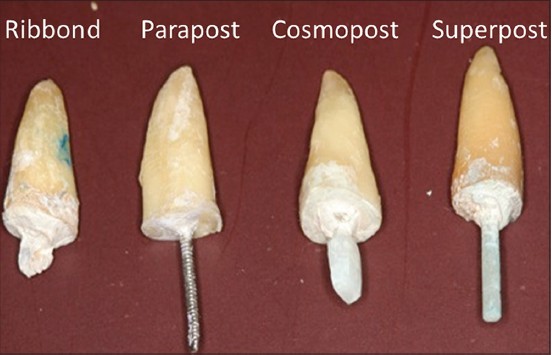  |
Microleakage of different dowel systems luted with resin cements |
p. 53 |
Necla Demir, Tevfik Yavuz, Hasan Orucoglu, A Nilgun Ozturk, Bora Ozturk
DOI:10.4103/2347-4610.131979 Aims: The purpose of this study was to compare microleakage of dowel systems: Stainless steel dowel system (SSD), resin-supported polyethylene fiber dowels (RSPFD), Zirconia dowels (ZD) and glass fiber dowels (GFD) luted with two different resin cements. Materials and Methods: The root canals of 96 teeth were restored and two resin cements (Multilink Automix and Clearfil Esthetic cement) were used in cementation procedure. Using the computerized fluid filtration method, microleakage of the specimens was measured at 1 week, and 6 months. Results: The data indicated that the microleakage values varied according to the luting cement used (P < 0.05). The initial microleakage of ParaPost was similar with the other dowel systems, but this microleakage increased over time (P < 0.05). In contrast; microleakage of Ribbond, Cosmopost and Superpost dowels remained constant (P > 0.05). Conclusion: Esthetic dowels tested exhibited less microleakage compared to stainless steel dowel system. Statistically, Multilink Automix cement showed higher microleakage than Clearfil Esthetic cement. |
| [ABSTRACT] [HTML Full text] [PDF] [Mobile Full text] [EPub] [Sword Plugin for Repository]Beta |
|
|
|
|
|
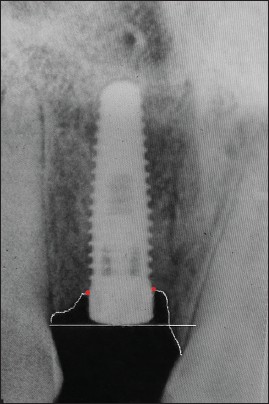  |
Original research radiological evaluation of marginal bone around dental implants: A pilot study |
p. 58 |
Anshul Chugh, Shikha Nandal
DOI:10.4103/2347-4610.131980 The use of dental implants has enabled the fabrication of highly functional and aesthetic restorations and improved the predictability of treatment. Standardized periapical radiographs at regular follow-up intervals are used to detect peri-fixtural radiolucency and/or progressive marginal bone loss or 'saucerization' around dental implants and thus to evaluate the success of implant. The aim of this study is to evaluate the early changes in the marginal bone level around dental implants through standard intraoral radiographs in the initial months of implant placement and to evaluate the relationship of various parameters i.e. gender, length and location of implants on amount of bone loss. |
| [ABSTRACT] [HTML Full text] [PDF] [Mobile Full text] [EPub] [Sword Plugin for Repository]Beta |
|
|
|
|
|
|
| CASE REPORTS |
 |
|
|
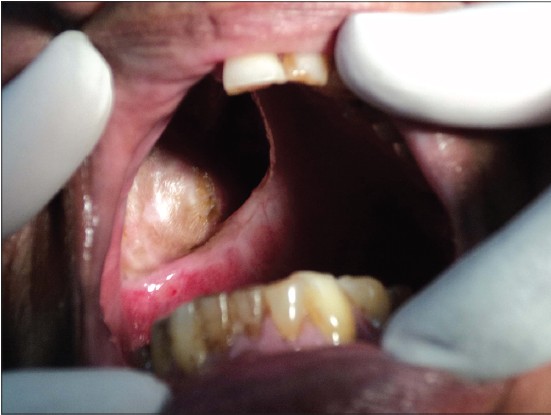  |
Rehabilitation of a partial maxillary defect with magnet retained two-piece hollow bulb obturator |
p. 62 |
Suryakant C Deogade, Sneha S Mantri
DOI:10.4103/2347-4610.131982 A restricted mouth opening in hemimaxillectomy patients can create a significant problem with insertion and removal of the obturator prosthesis. A two-piece obturator is an alternative management for such patients. The treatment of a patient with a hemimaxillectomy due to squamous cell carcinoma is presented in this clinical report. A sectional obturator prosthesis retained by magnets was fabricated to deal with trismus, fibrosis, and microstomia. The patient's esthetic and functional expectations were satisfied. The new generation of magnets with improved technology provides sufficient denture retention for clinical application. However, further follow-up may be necessary to ascertain the long-term usefulness of the magnet-retained obturator prosthesis, because of corrosion and further loss of magnetism. |
| [ABSTRACT] [HTML Full text] [PDF] [Mobile Full text] [EPub] [Citations (1) ] [Sword Plugin for Repository]Beta |
|
|
|
|
|
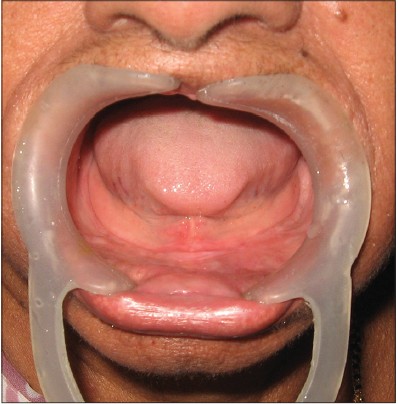  |
Conservative approach for the treatment of geriatric edentulous patient with grossly resorbed mandibular ridge |
p. 67 |
Rachana J Shah, Sujal G Shah, Vishal Chauhan
DOI:10.4103/2347-4610.131983 The construction of complete denture prosthesis for a geriatric patient with grossly resorbed mandible has always been a challenge to our profession. Poor mandibular ridges accompanied by thin and atrophic oral mucous membrane leads to increased bruising and damage under occlusal loading. Nutrition and diet play an important role in all edentulous patients, but particularly with the geriatric patient. This case report presents a conservative prosthodontic option that includes a modifi ed fi nal impression technique using admixed compound followed by permanent lining of the mandibular denture with a heat-cure silicone-based resilient soft liner along with dietary counseling. |
| [ABSTRACT] [HTML Full text] [PDF] [Mobile Full text] [EPub] [Sword Plugin for Repository]Beta |
|
|
|
|
|